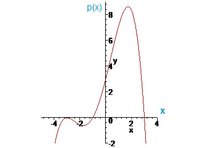View attachment 17252
Why is this not possible for a 4th degree polynomial?
I think I better stop posting. I have made errors in both my previous posts. Let's try for a
THIRD time. Maybe I shall get it right this time.
We all agree that f(x) is to be a polynomial of even degree > 2 with exactly 3 roots, at -3, -1, and 3. Plus the root at - 3 must have multiplicity. Finally, f(0) = 3.
Thus, f(x) must have the form
[MATH]f(x) = a(x + 3)^{2n}(x + 1)(x - 3).[/MATH]
You with me so far?
To keep things neat, I shall solve for the non-zero constant a last, but note that a < 0.
[MATH]\therefore f'(x) = a\{(2n)(x + 3)^{(2n-1)}(x + 1)(x - 3)(1) + (x + 3)^{2n}(1)(x - 3) + (x + 3)^{2n}(x + 1)(1) =[/MATH]
[MATH]a(x + 3)^{(2n-1)}\{(2n(x + 1)(x - 3) + (x + 3)(x - 3) + (x + 3)(x + 1)\} =[/MATH]
[MATH]a(x + 3)^{(2n-1)}\{(2nx + 2n)(x - 3) + x^2 - 9 + x^2 + 4x + 3\} =[/MATH]
[MATH]a(x + 3)^{(2n-1)}\{2nx^2 - 4nx - 6n + x^2 - 9 + x^2 + 4x + 3\} =[/MATH]
[MATH]a(x + 3)^{(2n-1)}\{(2n + 2)x^2 - 4(n - 1)x - (6n + 6)\}.[/MATH]
Let's hope I got the derivative correct this time.
[MATH]\therefore f'(0) = 0 \implies x = - 3 \text { or }[/MATH]
[MATH]x = \dfrac{4(n - 1) \pm \sqrt{16(n - 1)^2 - 4(2n + 2)(-1)(6n + 6)}}{2(2n + 2)} =[/MATH]
[MATH]\dfrac{4(n - 1) \pm \sqrt{16(n^2 - 2n + 1) + 4(12n^2 + 24n + 12)}}{2(2n + 2)} =[/MATH]
[MATH]\dfrac{4(n - 1) \pm \sqrt{16n^2 - 32n + 16 + 48n^2 + 96n + 48}}{2(2n + 2)} =[/MATH]
[MATH]\dfrac{4(n - 1) \pm \sqrt{64n^2 + 64n + 64}}{2(2n + 2)} = \dfrac{4(n - 1) \pm 8\sqrt{n^2 + n + 1}}{2(2n + 2)} =[/MATH]
[MATH]\dfrac{2(n - 1) \pm 4\sqrt{n^2 + n + 1}}{2n + 2}.[/MATH]
[MATH]\dfrac{2(n - 1) \+ 4\sqrt{n^2 + n + 1}}{2n + 2} > 0 \ \because n \ge 1.[/MATH]
Therefore, the local maximum must be in quadrant I, no matter what even degree the polynomial has.
[MATH](n - 1)^2 = n^2 - 2n + 1 < n^2 + n + 1 \implies 2(n - 1) < 2\sqrt{n^2 + n +1} < 4\sqrt{n^2 + n +1} \implies[/MATH]
[MATH]2(n - 1) - 4\sqrt{n^2 + n +1} < 0.[/MATH]
Therefore, Therefore, the local maximum must be in quadrant II, no matter what even degree the polynomial has.
As for a
[MATH]f(0) = 3 = a * 3^{2n} * 1 * (-\ 3) \implies a * 3^(2n) = -\ 1 \implies a = - \ \dfrac{1}{3^{2n}}.[/MATH]
If we take the special case of n = 1, the local minimum is when
[MATH]x = \dfrac{2(1 - 1) - 4\sqrt{1^2 + 1 + 1}}{2 * 1 + 2} = \dfrac{-\ 4\sqrt{3}}{4} = -\ \sqrt{3}.[/MATH]
The local maximum is when
[MATH]x = \dfrac{2(1 - 1) + 4\sqrt{1^2 + 1 + 1}}{2 * 1 + 2} = \sqrt{3}.[/MATH]
To sum up, there are an infinite number of polynomials of even degree, each with a local minimum in quadrant II and a local maximum in quadrant I. If I screwed this up again, I shall go to the corner for a day.

